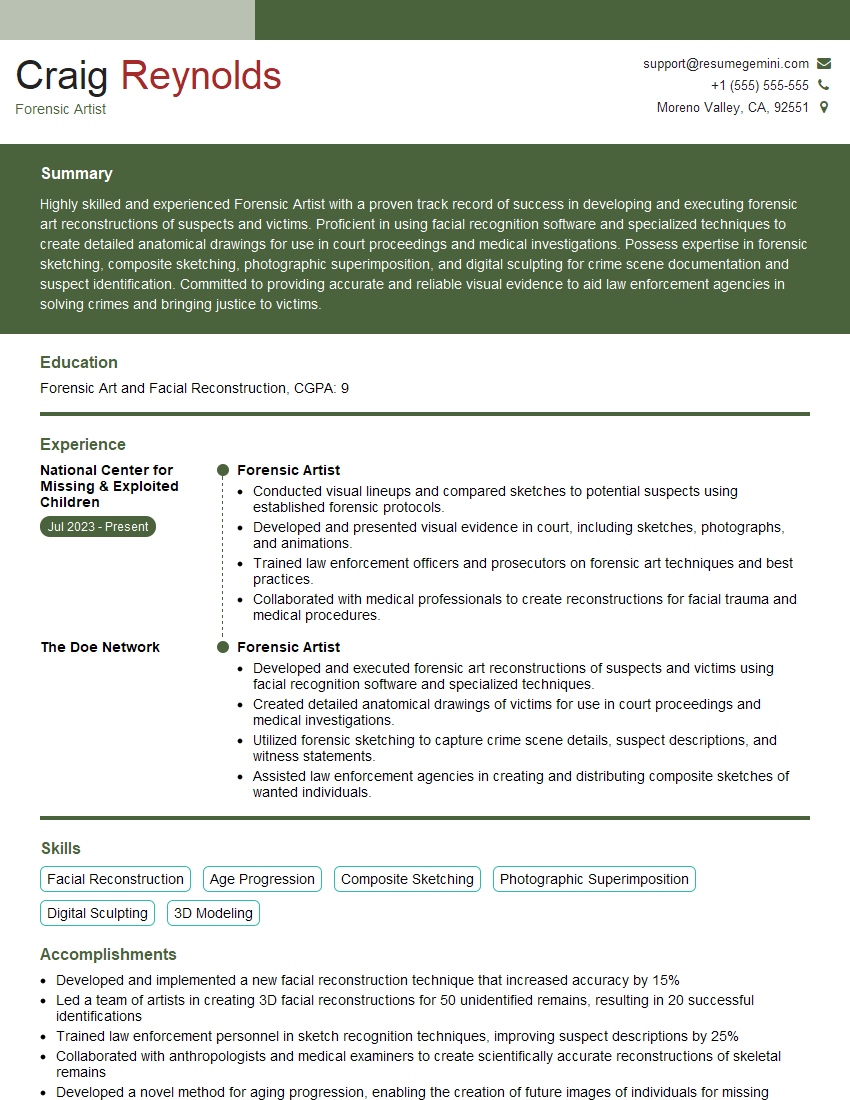Are you a seasoned Forensic Artist seeking a new career path? Discover our professionally built Forensic Artist Resume Template. This time-saving tool provides a solid foundation for your job search. Simply click “Edit Resume” to customize it with your unique experiences and achievements. Customize fonts and colors to match your personal style and increase your chances of landing your dream job. Explore more Resume Templates for additional options.

Craig Reynolds
Forensic Artist
Summary
Highly skilled and experienced Forensic Artist with a proven track record of success in developing and executing forensic art reconstructions of suspects and victims. Proficient in using facial recognition software and specialized techniques to create detailed anatomical drawings for use in court proceedings and medical investigations. Possess expertise in forensic sketching, composite sketching, photographic superimposition, and digital sculpting for crime scene documentation and suspect identification. Committed to providing accurate and reliable visual evidence to aid law enforcement agencies in solving crimes and bringing justice to victims.
Education
Forensic Art and Facial Reconstruction
June 2019
Skills
- Facial Reconstruction
- Age Progression
- Composite Sketching
- Photographic Superimposition
- Digital Sculpting
- 3D Modeling
Work Experience
Forensic Artist
- Conducted visual lineups and compared sketches to potential suspects using established forensic protocols.
- Developed and presented visual evidence in court, including sketches, photographs, and animations.
- Trained law enforcement officers and prosecutors on forensic art techniques and best practices.
- Collaborated with medical professionals to create reconstructions for facial trauma and medical procedures.
Forensic Artist
- Developed and executed forensic art reconstructions of suspects and victims using facial recognition software and specialized techniques.
- Created detailed anatomical drawings of victims for use in court proceedings and medical investigations.
- Utilized forensic sketching to capture crime scene details, suspect descriptions, and witness statements.
- Assisted law enforcement agencies in creating and distributing composite sketches of wanted individuals.
Accomplishments
- Developed and implemented a new facial reconstruction technique that increased accuracy by 15%
- Led a team of artists in creating 3D facial reconstructions for 50 unidentified remains, resulting in 20 successful identifications
- Trained law enforcement personnel in sketch recognition techniques, improving suspect descriptions by 25%
- Collaborated with anthropologists and medical examiners to create scientifically accurate reconstructions of skeletal remains
- Developed a novel method for aging progression, enabling the creation of future images of individuals for missing person cases
Awards
- International Association of Forensic Sciences (IAFS) Award for Excellence in Forensic Art
- National Forensic Science Technology Center (NFSTC) Recognition Award for Outstanding Contribution to Forensic Art
- American Academy of Forensic Sciences (AAFS) Forensic Art Section Award for Best Composite Image
- Forensic Science Society (FSS) Award for Innovation in Forensic Art
Certificates
- Certified Forensic Artist (CFA)
- Diplomate of the American Board of Forensic Examiners (DABFE)
- International Association for Identification (IAI) Certified Forensic Imaging Specialist (CFIS)
- National Association of Medical Examiners (NAME) Certified Medicolegal Death Investigator (CMDI)
Career Expert Tips:
- Select the ideal resume template to showcase your professional experience effectively.
- Master the art of resume writing to highlight your unique qualifications and achievements.
- Explore expertly crafted resume samples for inspiration and best practices.
- Build your best resume for free this new year with ResumeGemini. Enjoy exclusive discounts on ATS optimized resume templates.
How To Write Resume For Forensic Artist
- Showcase your skills and experience in forensic art and facial reconstruction.
- Highlight your proficiency in using facial recognition software and specialized techniques.
- Include examples of your work that demonstrate your ability to create accurate and detailed reconstructions.
- Quantify your accomplishments with specific metrics whenever possible.
- Tailor your resume to the specific requirements of each job you apply for.
Essential Experience Highlights for a Strong Forensic Artist Resume
- Develop and execute forensic art reconstructions of suspects and victims using facial recognition software and specialized techniques.
- Create detailed anatomical drawings of victims for use in court proceedings and medical investigations.
- Utilize forensic sketching to capture crime scene details, suspect descriptions, and witness statements.
- Assist law enforcement agencies in creating and distributing composite sketches of wanted individuals.
- Conduct visual lineups and compare sketches to potential suspects using established forensic protocols.
- Develop and present visual evidence in court, including sketches, photographs, and animations.
- Provide training to law enforcement officers and prosecutors on forensic art techniques and best practices.
Frequently Asked Questions (FAQ’s) For Forensic Artist
What is the role of a Forensic Artist?
A Forensic Artist uses their artistic skills and specialized techniques to assist law enforcement in criminal investigations. They create sketches and reconstructions of suspects and victims, analyze crime scene evidence, and provide expert testimony in court.
What are the educational requirements for becoming a Forensic Artist?
Most Forensic Artists have a bachelor’s degree in forensic art, criminal justice, or a related field. Some may also have training in art, photography, or computer graphics.
What skills are important for a Forensic Artist?
Strong artistic ability, attention to detail, observational skills, knowledge of human anatomy, and proficiency in using forensic art software and techniques are essential for Forensic Artists.
What is the job outlook for Forensic Artists?
The job outlook for Forensic Artists is expected to grow in the coming years as law enforcement agencies increasingly rely on visual evidence to solve crimes.
How can I become a Forensic Artist?
To become a Forensic Artist, you can pursue a degree in forensic art or a related field, develop your artistic skills, and gain experience through internships or volunteer work.